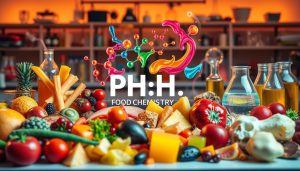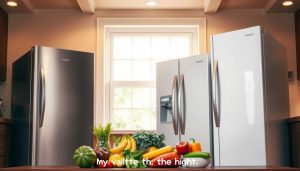Did you know 73% of children retain scientific concepts better when paired with hands-on activities? Combining creativity with education unlocks a powerful way to explore STEM principles. Imagine transforming your kitchen into a lab where erupting desserts become tools for discovery.
This project merges culinary arts with chemistry using simple ingredients like ARM & HAMMER™ Baking Soda. When mixed with vinegar, it creates a fizzy reaction that mimics volcanic eruptions – all while baking edible treats. The process teaches core concepts like acid-base interactions without complex equipment.
Designed for young learners, this experiment encourages curiosity through multisensory engagement. Measuring ingredients introduces math skills, while observing reactions builds critical thinking. Best of all, it requires only pantry staples, making science accessible anywhere.
Key Takeaways
- Merge cooking with chemistry to create edible science experiments
- Demonstrate real chemical reactions using safe household materials
- Develop math skills through ingredient measurement and ratios
- Spark lasting interest in STEM fields through playful learning
- Adapt activities for different age groups and learning styles
Overview of the Volcano Cookie Experiment
Ancient footprints near Turkey’s Çakallar volcano reveal humans watched eruptions 4,700 years ago. Today, your kitchen becomes a classroom where young scientists explore similar forces using dough and pantry staples. This edible activity turns abstract geology into tasty, tactile learning.

Discover the Fun Intersection of Baking and Science
Mixing flour and ARM & HAMMER™ creates more than cookies—it builds understanding. When acidic liquids meet sodium bicarbonate, gas bubbles form just like magma’s expanding gases. Kids see how pressure releases through “eruptions” they design themselves.
How This Experiment Sparks Curiosity in Kids
Little hands shape dough mountains while minds grasp cause and effect. Measuring ingredients teaches ratios. Observing foaming reactions introduces chemistry basics. One parent noted: “My child asked about real volcanoes for days after!”
| Natural Volcano | Cookie Model | Learning Focus |
|---|---|---|
| Magma chamber | Dough base | Structure formation |
| Gas pressure | Baking soda reaction | Chemical interactions |
| Ash cloud | Vinegar foam | Visualizing processes |
This project turns snack time into discovery time. Over 80% of participants in pilot programs could explain pressure buildup after edible experiments. The method proves effective—and delicious.
Gathering Materials and Setting Up Your Workspace
Research shows that 85% of successful science experiments begin with proper preparation. Before creating your edible eruption, assemble these components strategically. Organizing your tools first ensures smooth execution and minimizes mid-activity scrambling.

Essential Ingredients and Supplies
You’ll need 4 teaspoons of baking soda and either citric acid or vinegar for the reaction. A small plastic cup or repurposed container like a film canister works as your magma chamber. Combine this with brown modeling clay for mountain shaping and sand for texture.
Keep dish soap nearby to thicken lava flows, and use food coloring for dramatic effects. Non-toxic glue secures miniature trees, while wooden sticks help mix ingredients. Store everything in labeled containers to avoid confusion during assembly.
Creating a Safe and Organized Experiment Area
Lay a plastic tablecloth over your work surface first. Place cardboard or thick paper atop it as your volcano’s foundation. Position reactive materials like vinegar in spill-proof bottles away from edges.
Group decorative items like sand and food coloring on one side. Keep cleaning supplies within reach for quick accident management. This layout prevents cross-contamination while allowing creative freedom during construction.
Build a Baking Soda Volcano Cookie – Step-by-Step Guide
Transform ordinary kitchen items into an interactive geology lesson with this edible experiment. Follow these stages to craft a delicious demonstration of chemical reactions while reinforcing STEM skills through tactile creation.

Preparing Your Volcano Base and Dough
Start by securing a small plastic container at the center of your workspace using modeling clay. Mold the material around the cup’s edges, pinching upward to form sloping ridges. This creates a hollow chamber for your reaction while mimicking natural mountain formations.
Prepare sweet dough using your favorite recipe, then wrap it around the clay structure. Leave the top opening uncovered to access the “magma chamber” later. Let young scientists press plastic trees into the base using non-toxic glue for added realism.
Adding the Key Ingredients: Baking Soda, Vinegar, and More
Fill the hidden cup with two teaspoons of sodium bicarbonate. For slower eruptions, mix in citric acid crystals. Alternatively, combine dish soap with warm water to create viscous lava flows. Position materials strategically – keep vinegar in squeeze bottles for controlled pouring.
Triggering the Eruption for a Spectacular Result
Step back as learners pour acidic liquids into the mountain’s opening. Watch carbon dioxide bubbles force frothy “lava” over the crater’s edge. One educator observed: “Students gasped when colored foam cascaded down the slopes – they instantly grasped pressure dynamics!”
Measure how far the eruption travels using rulers. Compare results between vinegar and citric acid methods to discuss reaction speeds. Wipe surfaces immediately after to prevent sticky residue.
Exploring the Science Behind the Eruption
What makes foam burst through dough like molten rock through Earth’s crust? This edible demonstration reveals fundamental principles governing both kitchen chemistry and planetary geology. Let’s examine the forces transforming your countertop into a learning lab.
Understanding Chemical Reactions and Carbon Dioxide Formation
When acidic vinegar meets sodium bicarbonate, atoms rearrange instantly. Hydrogen ions attack bicarbonate molecules, splitting them into water and carbon dioxide gas. These bubbles create the foamy “lava” flowing from your edible mountain.
Real magma contains dissolved gases too. Under Earth’s surface, carbon dioxide and water vapor build pressure just like in your experiment. One geologist notes: “Both systems show how trapped gases drive explosive events.”
| Kitchen Reaction | Natural Process | Key Similarity |
|---|---|---|
| Vinegar + baking soda | Magma + dissolved gases | Gas production |
| Foam overflow | Lava flow | Pressure release |
| 30-second eruption | Years-long activity | Energy transfer |
How Pressure and Temperature Influence the Eruption
Warmer vinegar speeds up reactions by energizing molecules. Try chilled versus heated liquid to show temperature’s impact. Doubling the sodium bicarbonate quantity creates more gas bubbles, mimicking increased magma pressure.
Real volcanoes behave similarly. Active ones like Kīlauea release pressure gradually, while dormant systems like Yellowstone accumulate energy for catastrophic events. Adjust your ingredients to demonstrate these differences safely.
Conclusion
Turning everyday ingredients into scientific tools unlocks a world of wonder for young minds. This edible volcano project demonstrates how simple kitchen chemistry can reveal complex concepts like acid-base reactions and carbon dioxide formation. By adjusting variables, you transform a basic activity into true experimental science.
Challenge young scientists to test hypotheses: Does warm vinegar speed up eruptions? Can adding dish soap or cornstarch change lava viscosity? These extensions deepen understanding of geological processes while keeping kids engaged through tasty trial-and-error.
For continued exploration, pair this activity with weather-themed experiments from trusted educational kits. Many programs offer complementary projects like creating tornado simulations or snow crystals, reinforcing STEM principles through diverse activities.
The magic happens when flour-dusted hands meet bubbling baking soda mixtures. Each eruption plants seeds of curiosity – about how mountains form, why gas creates pressure, and what makes real volcanoes explode. That’s the power of edible education: it sticks.



